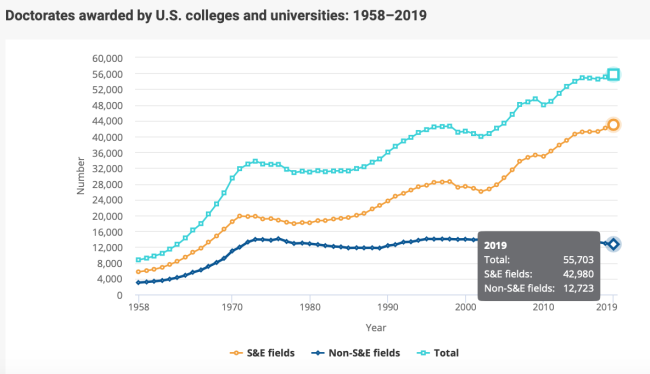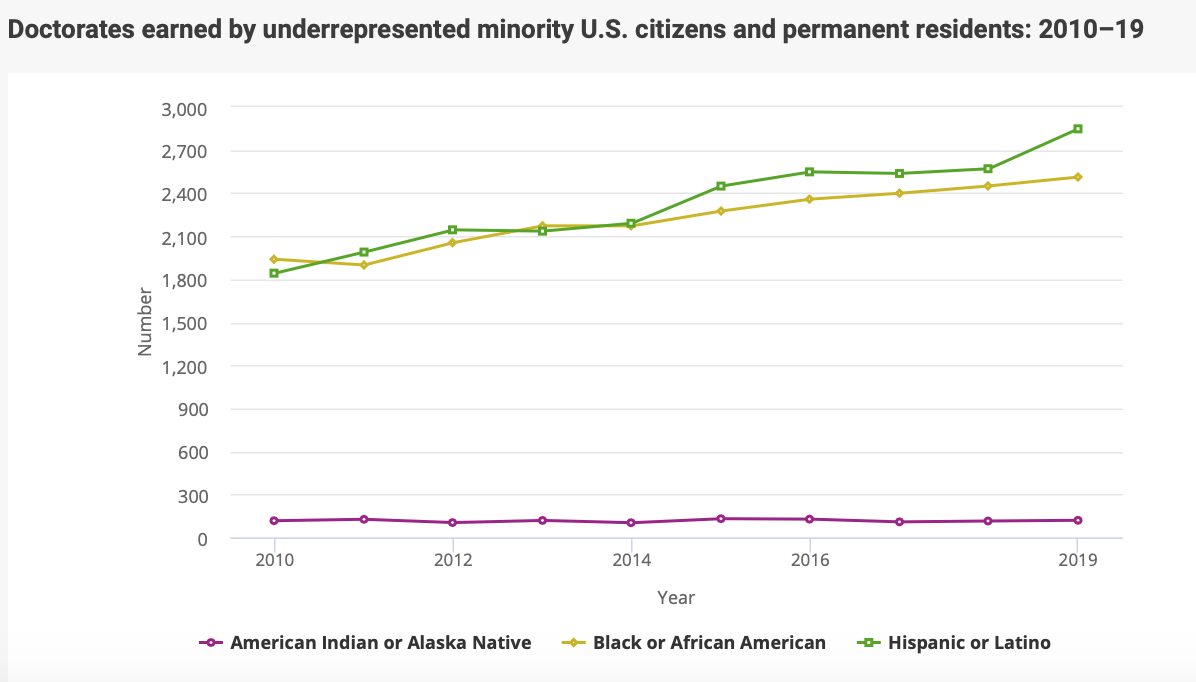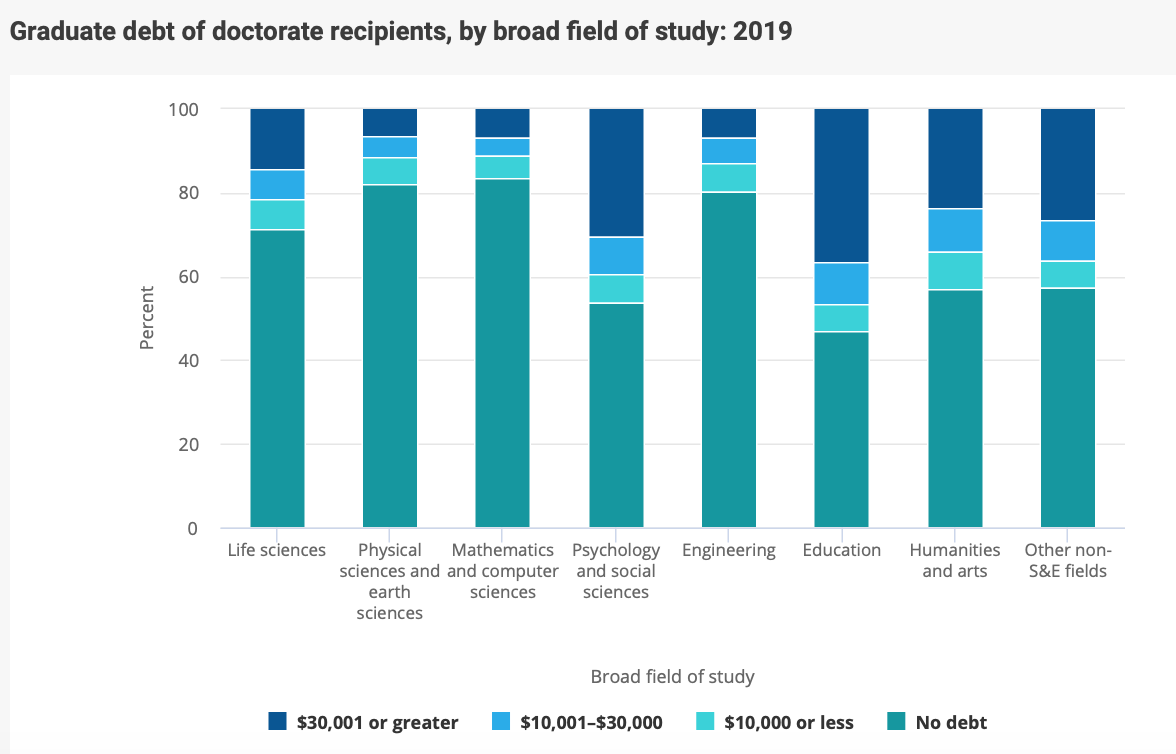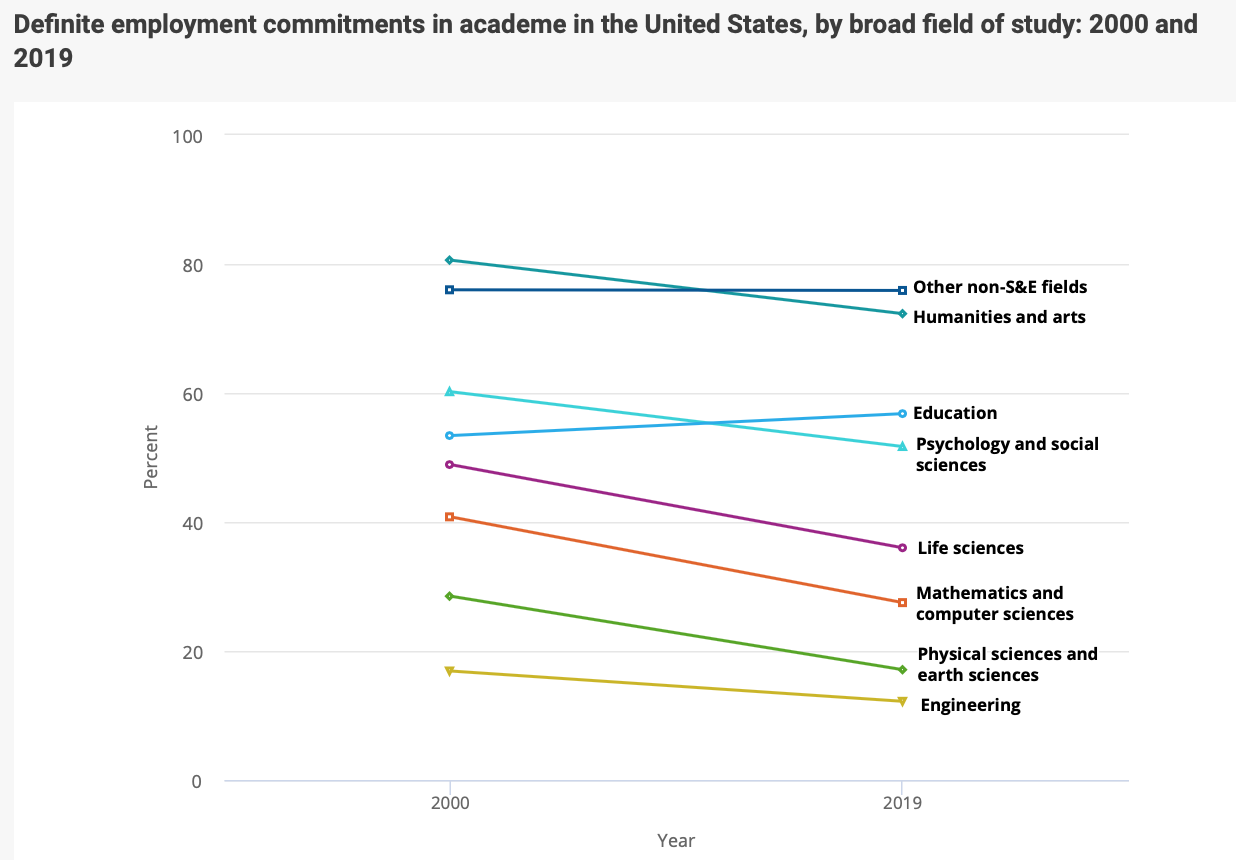You have /5 articles left.
Sign up for a free account or log in.

Doctorates awarded through 2019 in science and engineering and non-science and engineering fields
National Science Foundation
Some 55,703 students earned doctorates in 2019, a modest 1 percent increase from 2018, according to the National Science Foundation’s annual Survey of Earned Doctorates. This is below the 3 percent annual average growth since the survey began in the 1950s.
There were bigger gains among underrepresented minorities, however -- a 7 percent increase in number of Ph.D.s earned, year over year. This is good news for institutional diversity efforts, both in terms of keeping minority scholars in the Ph.D. pipeline and expanding the pool of potential faculty candidates. At the same time, the share of underrepresented minorities who earned their Ph.D.s in 2019 was small: 5,480 of the whole, or less than 10 percent.
 While family education levels are rising across all racial groups, underrepresented minority Ph.D.s (Black, Latinx and Native American students) were still less likely to have at least one parent with a bachelor’s degree than their Asian or white counterparts. This puts the gains among underrepresented minority groups even more into perspective.
While family education levels are rising across all racial groups, underrepresented minority Ph.D.s (Black, Latinx and Native American students) were still less likely to have at least one parent with a bachelor’s degree than their Asian or white counterparts. This puts the gains among underrepresented minority groups even more into perspective.
In terms of gender, women were still more than half of all doctorate recipients in the life sciences, psychology and social sciences, education, humanities and arts and what the NSF calls other non-science and engineering fields in 2019. Women earned one-third of doctorates in the physical sciences and earth sciences and one-quarter of doctorates in engineering, math and computer science.
The share of doctorates awarded to temporary visa holders was high -- even a few percentage points higher than usual, at 38 percent. That’s despite ongoing challenges for international students with respect to their legal status under the Trump administration.
In another bit of good news, definite employment prospects for Ph.D.s across disciplines continued to increase, following lower such commitments from employers in 2014-16.
COVID-19 could upend much of these gains and worsen trends that lie just below the surface-level data, however.
Trouble Ahead
L. Maren Wood, a Ph.D. career adviser and founder of Beyond the Professoriate, said that many graduate programs are temporarily halting or limiting admissions due to COVID-19. And while many current graduate students say that they are planning to delay graduation to avoid hiring freezes across the already icy academic job market, Wood’s advice is “run, don’t walk, out of academia.”
“Delaying graduation, taking contingent positions, or taking on multiple postdocs will just delay a career transition,” she said. “So few people will end up landing a tenure-track job at the best of times, and there are so many other places where Ph.D.s build meaningful careers.”
To Wood’s point, all disciplines except for the arts and humanities saw higher median expected salaries in industry in 2019 rather than postdoctoral positions and other jobs in academe. That’s typical.
And in a key metric that is more often associated with undergraduate education, some 71 percent of Ph.D.s in science and engineering fields -- excluding psychology and the social sciences -- reported having no debt related to their graduate education.
Yet in psychology and the social sciences, humanities and the arts, among other fields, the share of doctorate recipients with no debt was about half. In education, it was less than half.
Wood said she found it “deeply troubling” that roughly one-third of social science Ph.D.s and scholars of education had $30,000 or more in graduate education-related debt, as did nearly one-quarter of humanities Ph.D.s. surveyed.
 The survey found that the majority of doctorate recipients earn a master’s degree before their doctorate, with the exception of those in the biological and biomedical sciences fields.
The survey found that the majority of doctorate recipients earn a master’s degree before their doctorate, with the exception of those in the biological and biomedical sciences fields.
Troubling Wood still was the finding that doctorate recipients in fields with the highest median cumulative debt were reported to have the lowest median expected salaries, she said. Is “investment,” or taking out loans for a degree, “helping or impeding financial security for Ph.D.s” in these fields, Wood asked?
Graduate Students Are Hurting
“Forty percent of humanities Ph.D.s have no definitive employment plans,” Wood said, diving deeper into the top-line 2019 data on career prospects. “That’s staggering. When you consider that they also experience higher rates of depression and career uncertainty as graduate students, that number becomes even more concerning.”
Indeed, a separate, new NSF-funded study of graduate student mental health during the pandemic found “concerning levels of anxiety, depression, and P.T.S.D. symptoms.” Many of the 3,500 surveyed students described “economic precarity related to food and housing insecurity and a lack of institutional support.” The study warns that the pandemic’s effects may “be long-lasting, as many graduate students are planning longer research timelines and time to degree extensions, feel pessimistic about their career prospects, and anticipate career changes.”
The mental health report also says graduate students who identify as women or trans, nonbinary or genderqueer; international students; and parents and caretakers experienced more negative mental health effects and degree delays. More graduate students who identified as Black or Indigenous also reported having relationships with others at high risk for negative outcomes from COVID-19 or having lost someone close to them due to COVID-19.
Ultimately, the study found that students may be experiencing "ongoing trauma responses to these combinations of events and experiences," and it recommends institutions act to help them, drawing on a trauma-informed framework.
In findings from the Survey of Earned Doctorates that have other implications for underrepresented students, the share of Black Ph.D.s with bachelor’s degrees from HBCUs declined over the last decade, even as the number of Black or African American undergraduate students increased and the number of institutions remained nearly constant.
Over the same period, the share of Latinx doctorate recipients with bachelor’s degrees from high-Hispanic-enrollment institutions increased across fields.
Outlook Uncertain
Robert Townsend, interim director of humanities, arts and culture programs at the American Academy of Arts and Sciences, said the humanities “have been striving for decades to improve diversity in their doctoral student population, so at first blush it seems notable that there has been a substantial gain there.” Yet on closer inspection, he said, gains primarily reflect the rising share of Latinx students across the graduate student population.
Townsend also said there’s a “parallel increase” in the share of new Ph.D.s who earned credits and associate’s degrees at community colleges.
“Some of the efforts to diversify the student population have focused particularly on community colleges as a key entry point for first-generation students, and tried to open doors to those students,” he said, “so perhaps that effort is showing some success.” 
Like Wood, Townsend said he remained on high alert regarding humanities job prospects for Ph.D.s as a result of COVID-19.
“When the job market fell during the Great Recession, it occurred at the end of more than a decade of rising majors and enrollments in most fields,” he said. “Now we are into almost a decade of declining majors, [so] the context for the academic job market for the humanities looks particularly grim for the near future.”
Wood said that following 2009, there was a brief supposed recovery in the job market, “followed by a steady decline and a stabilization that is basically rock bottom. And there were multiple cohorts of Ph.D.s competing for those jobs.”
This time, she said, “My advice is that Ph.D.s should consider private-sector careers, and they should begin building networks in small to midsized businesses.” And “for anyone who can graduate this year, they should.”





